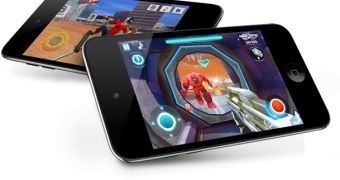Apple’s next iPod touch will reportedly boast a 3D screen that will enable viewers to experience 3D video without the need of special glasses, as proposed in a patent application recently won by the Cupertino, California-based giant.
Japan’s Macotakara blog cites sources as saying that Apple is ready to start producing small 3D panels akin to those made by Sharp, 9to5mac reports, based on a rough Google translation.
The Mac-centric blog speculates that such a rumor will undoubtedly make the high-ups at Nintendo restless, knowing that the Japanese giant is gearing up to introduce its Nintendo 3DS gaming system this week.
As for the Macotakara report, it speculates that an upcoming iPod touch equipped with such a screen may also have a 3D integrated gaming interface, the ability to position and control a game using the Face Time camera, as well as face recognition.
Apple heavily touts its iPod touch as a great gaming platform and pocket computer, in addition its media player capabilities.
Recent iOS 4.3 SDK findings indicate that Apple is on track to adopt a new graphics solution for its portable devices, which enables both these rumors to fuel one another.
Moreover, Apple is known to have been granted a U.S. patent for three-dimensional display system which, in theory, would allow multiple viewers to see a high-quality 3D image without the special glasses.
According to the patent filings, viewers would not have to sit in pre-determined positions, making the 3D experience proposed by Apple extremely enticing.
“A three-dimensional display system provides a projection screen having a predetermined angularly-responsive reflective surface function,” the abstract of the invention reads.
In the patent summary, Apple talks about a reflective screen with a rippled texture in what would become an autostereoscopic projection system.
To project images to each eye without the need of special equipment (glasses), the system would track the viewer's eyes and calculate their position in space, then project each pixel of the stereoscopic images to a precise spot on one of the screen's ripples, reflecting it into one or other of the viewer's eyes.

 14 DAY TRIAL //
14 DAY TRIAL //